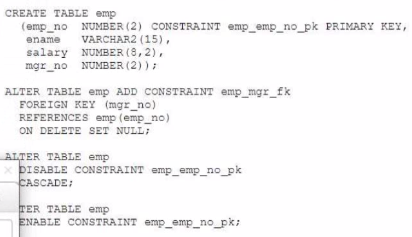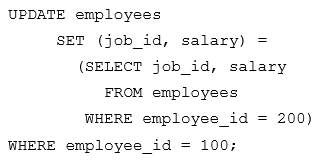Oracle 1z0-082 - Oracle Database Administration I
Which three statements are true about the DESCRIBE command? (Choose three.)
Which statement is true about the INTERSECT operator used in compound queries?
Examine the description of the CUSTOMERS table:

You want to display details of all customers who reside in cities starting with the letter D followed by at least two characters.
Which query can be used?
You want to apply the principle of Least Privilege in all your live databases.
One of your requirements is to revoke unnecessary privileges from all users who have them using Privilege Analysis.
Which three types of analyses can be done using the DBMS_PRIVILEGE_CAPTURE package? (Choose three.)
Which three files are used by conventional path SQL*Loader when the TABLE option is not specified? (Choose three.)
Which three statements are true about Deferred Segment Creation in Oracle databases?
Examine these SQL statements which execute successfully:

Which two statements are true after execution?
Table EMPLOYEES contains columns including EMPLOYEE_ID, JOB_ID and SALARY.
Only the EMPLOYEE_ID column is indexed.
Rows exist for employees 100 and 200.
Examine this statement:

Which two statements are true? (Choose two.)
Which three statements are true about the Oracle join and ANSI join syntax? (Choose three.)
The ORCL database has RESUMABLE__TIMEOUT = 7200 and DEFERRED_SEGMENT_CREATION = FALSE
User U1 has a 1 MB quota in tablespace DATA.
U1 executes this command:
SQL> CREATE TABLE t1 AS
(SELECT object_name, sharing, created
FROM dba_objects);
U1 complains that the command is taking too long to execute.
In the alert log, the database administrator (DBA) finds this:
2017-03-06T12:15:17.183438+05:30
statement in resumable session ‘User U1(136), Session 1, Instance 1’ was suspended due to ORA-01536: space quota exceeded for tablespace ‘DATA’
Which are three actions any one of which the DBA could take to resume the session? (Choose three.)



